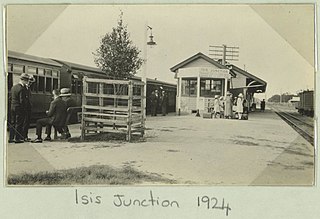Frederic Herbert (Herb) Faircloth (1870–1925) was an architect in Bundaberg, Queensland, Australia. Many of his buildings are now heritage-listed.

The Childers Bakery is a heritage-listed bakery at 82 Churchill Street, Childers, Bundaberg Region, Queensland, Australia. It was designed by F H Faircloth and built in 1902. It is also known as A.E. Gorrie, Baker and Confectioner, Isis Bakery, Childers Hot Bread and Cake Shop, and Sutton's Bakery. It was added to the Queensland Heritage Register on 21 October 1992.
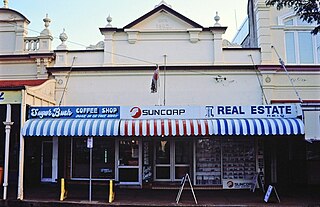
Kerr's Building is a heritage-listed shop at 84-86 Churchill Street, Childers, Bundaberg Region, Queensland, Australia. It was built c. 1902. It is also known as Crow & Kingston and Kingston and Kingston. It was added to the Queensland Heritage Register on 25 June 1993.

The Old Butcher's shop is a heritage-listed former butcher shop at 6 North Street, Childers, Bundaberg Region, Queensland, Australia. It was built from c. 1896 to c. 1902. It is also known as HR Lassig butchers, Leatherarts, and Wrench and Thompson butchers. It was added to the Queensland Heritage Register on 21 October 1992.

Hotel Childers is a heritage-listed hotel at 59 Churchill Street, Childers, Bundaberg Region, Queensland, Australia. It was built from c. 1895 to 1930s. It is also known as Queen's Hotel. It was added to the Queensland Heritage Register on 21 October 1992.

The National Australia Bank is a heritage-listed bank building at 61 Churchill Street, Childers, Bundaberg Region, Queensland, Australia. It was designed by Hubert George Octavius Thomas and built c. 1900. It is also known as Bank of Northern Queensland, Bank of Queensland, and National Bank of Australasia. It was added to the Queensland Heritage Register on 21 October 1992.

Childers Post Office is a heritage-listed former post office at Bruce Highway, Childers, Bundaberg Region, Queensland, Australia. It was designed by Queensland Colonial Architect's Office and built from 1890 to 1910. It is also known as Childers Heritage Shop. It was added to the Queensland Heritage Register on 24 January 2003.

Federal Hotel is a heritage-listed hotel at 71 Churchill Street, Childers, Bundaberg Region, Queensland, Australia. It was built c. 1907. It was added to the Queensland Heritage Register on 21 October 1992.

Grand Hotel is a heritage-listed hotel at 106-110 Churchill Street, Childers, Bundaberg Region, Queensland, Australia. It was designed by Anton Hettrich built from 1899 to 1900. It is also known as Childers Hotel. It was added to the Queensland Heritage Register on 21 October 1992.
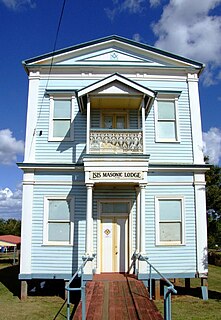
Isis Masonic Lodge is a heritage-listed masonic temple at 18 Macrossan Street, Childers, Bundaberg Region, Queensland, Australia. It was designed by F H Faircloth and built from 1897 to 1909. It is also known as Corinthian Lodge. It was added to the Queensland Heritage Register on 28 April 2000.

Queensland National Bank is a heritage-listed former bank building at 50 Churchill Street, Childers, Bundaberg Region, Queensland, Australia. It was designed by Philip Oliver Ellard Hawkes and built in 1919. It is also known as Childers Travel World, Wrench & Cobb, and Ye Olde Boutique. It was added to the Queensland Heritage Register on 21 October 1992.

Ellwood & Co Drapery is a heritage-listed shop at 62 Churchill Street, Childers, Bundaberg Region, Queensland, Australia. It was designed by F H Faircloth and built c. 1907. It is also known as F. Ellwood & Co Drapery, Boys Department Store, Dimmeys, and Joys Hairdress. It was added to the Queensland Heritage Register on 21 October 1992.
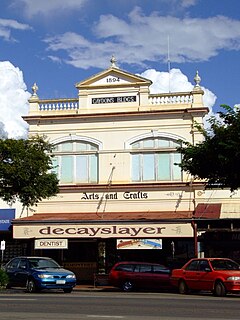
Childers Pharmaceutical Museum is a heritage-listed former pharmacy and now museum at 88-90 Churchill Street, Childers, Bundaberg Region, Queensland, Australia. It was designed by F H Faircloth and built from 1902 to 1909. It is also known as Gaydon's Pharmacy and Tourist Information Centre. It was added to the Queensland Heritage Register on 21 October 1992.
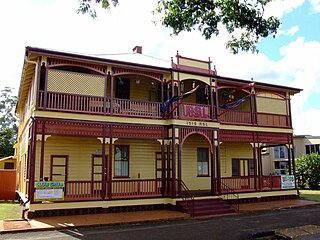
Childers RSL Club is a heritage-listed former bank and now Returned and Services League of Australia club house at 55 Churchill Street, Childers, Bundaberg Region, Queensland, Australia. It was designed by James Percy Owen Cowlishaw and built from 1900 to c. 1909. It was formerly a branch of the Commercial Banking Company of Sydney and is also known as the RSSAILA Club or the Isis RSL Club. It was added to the Queensland Heritage Register on 21 October 1992.

The Coronation Building is a heritage-listed row of shops at 102-108 Churchill Street, Childers, Bundaberg Region, Queensland, Australia. It was added to the Queensland Heritage Register on 21 October 1992.

Shops and Cafe is a heritage-listed row of shops at 54–58 Churchill Street, Childers, Bundaberg Region, Queensland, Australia. It was designed by F H Faircloth and built from c. 1912 to 1930s. It was added to the Queensland Heritage Register on 21 October 1992.

Jeffery's Building is a heritage-listed retail shop at 66-70 Churchill Street, Childers, Bundaberg Region, Queensland, Australia. It was designed by F H Faircloth and built in 1902. It is also known as Childers Medical Centre, Foodland, and R & D Meats and DJG Fruit & Vegetable shop. It was added to the Queensland Heritage Register on 21 October 1992.

The Hardware Store is a heritage-listed row of shops at 74-78 Churchill Street, Childers, Bundaberg Region, Queensland, Australia. It was designed by F H Faircloth and built in 1902. It is also known as Mitre 10, Silly Solly's, Pettigrew's Hardware, and Wyper Brothers Ironmongery. It was added to the Queensland Heritage Register on 21 October 1992.

Mellors Drapery and Haberdashery is a heritage-listed shop at 28 Capper Street, Gayndah, North Burnett Region, Queensland, Australia. It was built in 1922. It is also known as Overells. It was added to the Queensland Heritage Register on 8 August 1994.








